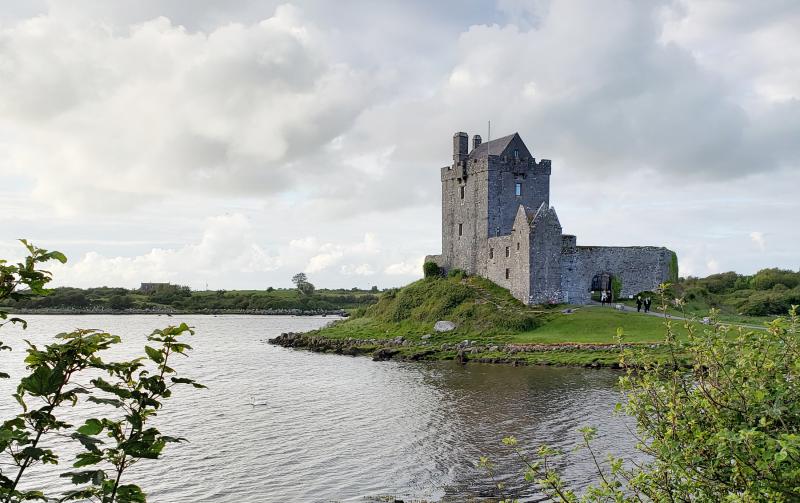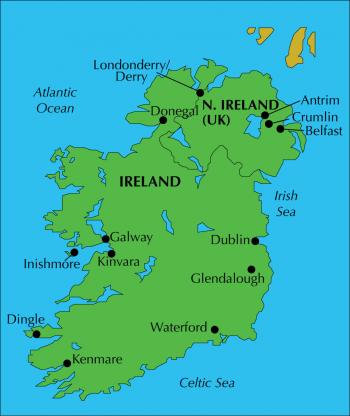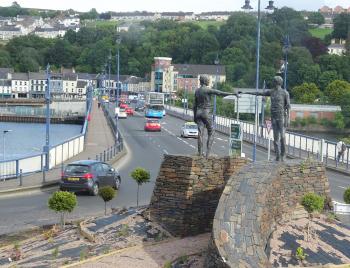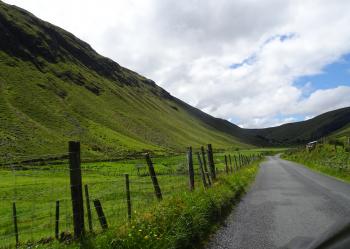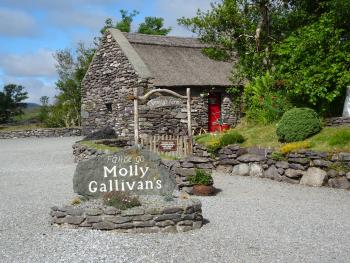Sites to see on a second trip to the Emerald Isle
This article appears on page 6 of the August 2020 issue.
There are classic, iconic sites one must see on a first trip to Ireland — wonderful locations such as the Cliffs of Moher, the Ring of Kerry and Temple Bar. On our first visit, my husband, Emmett Lee, and I saw all of those plus a few others, spending two weeks exploring, but for our latest trip, in June 2019, we planned 24 days of sightseeing to visit places we had missed the first time.
We covered Northern Ireland and the northwest counties of the Republic of Ireland during the first two weeks, then crossed the island at the belt and enjoyed another 10 days in the south.
Making plans
As we usually do on our travels, we booked two or more nights in each location when we could to get a better feel for the village or city we were visiting. We used several different services to find lodging; mostly we preferred B&B-type stays.
Since we were traveling with a teen, our granddaughter, we required a larger room or an apartment. In most cases, prices for a couple would be a little less than what we paid.
In order to do a trip like ours, you’ll need to summon up the courage to drive it! It’s not difficult; it just requires a change of mind-set.
We use Auto Europe often for our travels, and we’ve found that their European website (autoeurope.eu) gives us location drop-off and pickup options that the US site (autoeurope.com) does not, so try both.
Roads in Ireland are often extremely narrow, sometimes with just enough room for one car, but we found locals to be helpful and patient with us.
Notable sites
We started out heading north from Dublin’s airport on the M1 motorway to visit Antrim in Northern Ireland, where my great-grandfather was born.
Many first visits to Ireland include Brú na Bóinne, with the ancient passage tomb of Newgrange in County Meath, north of Dublin. However, as we headed north toward Antrim, we chose instead to visit two sites that were new to us: Knowth, a larger tomb complex, and the Battle of the Boyne site. These added a layer of Irish history that we didn’t experience on our first trip and increased our knowledge of the scope of the country’s ancient sites.
Dating to around 3200 BC, Knowth is an ancient settlement that was inhabited by succeeding generations of people over centuries.
At the visitor centers at Newgrange and Knowth — and many other sites in Ireland — you can purchase an OPW (Office of Public Works) Heritage Card (€10, or $11.25, for children and €30 for retirees, like us), which allows access to many, but not all, historical sites in the Republic for an entire year. It helps to support their maintenance and the guides and research that keep the history alive.
Heritage Cards are accessible at many places, which you can find listed online (heritageireland.ie/en/info/heritagecards), so there’s no need to buy one before leaving home.
The site of the Battle of the Boyne, just 8 kilometers farther along the highway, is the location of the 1690 battle for Irish rule between King James II of England and King William of Orange, both of whom were on the battlefield in person. Over 60,000 men fought, and more than 1,500 died.
One thing our visit illustrated is that the struggles of Ireland are rooted far deeper than The Troubles of the 20th century that we had known about from our world history lessons.
About 30 kilometers farther up the River Boyne sits Trim Castle. Since we had plenty of time before we were scheduled to arrive at our B&B in Antrim, we decided to make it our first castle visit.
It might be familiar to some film buffs from scenes in the movie “Braveheart.” It was not rebuilt but was restored in a way that visitors can see much of the structure as it was in its heyday.
Building was begun around 1172 by Hugh de Lacy, and it is the largest Norman castle in Ireland.
Heading north
Traveling farther north, using the side roads instead of the M1, we slipped into Northern Ireland without a sign, border crossing or any indication that we had moved into another country.
We’ve found that fewer tourists visit Northern Ireland on a trip to the Emerald Isle, but this was our second visit, and I highly recommend adding it to your itinerary.
For our stay in County Antrim, we chose a small B&B that was right on the shores of Lough Neagh, just a short distance from Belfast’s airport. At the Hayloft at the Bay Cottages (baycottageireland.com), outside Crumlin, we’d booked an apartment with a kitchenette, a sofa sleeper for our granddaughter and a separate bedroom.
The breakfasts made by our host, Elizabeth, were spectacular, with fresh Irish breads and rolls, homemade jams and a full Irish breakfast or cereal, yogurt and fruit. She was also a wealth of knowledge about the area and recommendations for things to see and do.
We stayed four nights for €436, booked through Hotels.com.
Hillsborough Castle and Gardens and Mount Stewart are palatial homes with gardens. The first is a Historic Royal Palace and serves as the home of the Secretary of State for Northern Ireland, also providing frequent lodging for the Royal Family — a particular favorite of Prince Charles and Camilla. Mount Stewart was a recent subject of a British documentary we’d seen, so we were delighted to get to visit there, too!
On this portion of our trip, we skipped Belfast proper, as we would be coming back later on a cruise. North of our B&B, we visited the Antrim coast’s many sites, including Carrickfergus Castle, just north of Belfast, the Carrick-a-Rede rope bridge (but from afar…. We opted not to cross it!) and the village of Ballycastle, the ferry port to Rathlin Island.
Because I love puffins, we took the ferry to visit the RSPB Rathlin West Light Seabird Centre (www.rspb.org.uk). The ferry from Ballycastle (£14, or $17.50, for adults, £6 for children) zips over to Rathlin Island in just a few minutes, and the local bus takes you to the seabird research and breeding center (£5, adults).
The center is the home to hundreds of thousands of breeding seabirds — guillemots, kittiwakes, razorbills and fulmars — including a colony of puffins, which you can easily pick out from a distance by their orange beaks and feet.
Before catching our ferry back to the Antrim coast, we enjoyed a walk near the village, visiting seals on the rocks just a few hundred yards from the port.
Our next stop was the Giant’s Causeway, often on the itinerary for a first visit to Northern Ireland but worth a second! The myths and legends are as spectacular as the site itself, featuring giant hexagonal columns of volcanic rock.
You can visit the site for free; just park on the street and walk around the large visitor center. The cost (£11, adults) is for entry to the visitor center and parking there.
Remember, you are now in Northern Ireland, so the OPW Heritage Card no longer works!
Derry
Our next two nights were at the Bridge B&B (3 Dacre Terrace; bridgebnb.com), located right at the end of the bridge into Derry. Derry/Londonderry is split by the River Foyle, which forms part of the boundary between the UK and the Republic of Ireland.
Those who avoided Northern Ireland in the past because of worries about violence can rest assured that there is peace. The 1998 Good Friday Agreement has brought a very welcome respite from trouble, and the people everywhere in Northern Ireland welcome visitors. We enjoyed a view of the peace monument from the window of our room (£99) at the Bridge B&B.
In Derry, we chose a free walking tour of the city. Our goal was to see the famous murals about the conflict and learn a bit more about it, as well as walk most of the walls around the city center. This is the only completely walled city still in Ireland, and the walls have a story to tell too!
From the walls, you look down onto the section of the city, the Bogside, where the 1972 Bloody Sunday conflict happened. This clash between protesting Bogside residents and the British army resulted in a number of unarmed protesters being killed, sparking the riots and unease that transpired over the next 30 or so years.
On our way out of Londonderry, we visited a rebuilt ringfort, Grianan of Aileach, located just a few kilometers west, as we traveled back into the Republic. An example of an ancient ringfort, it gave us a feeling of the desolation of the people in those days — windswept, but with a wonderful view of the surrounding countryside and the northern coast.
Wild Atlantic Way
We traveled on into Glenveagh National Park in County Donegal. The area is a bit more rugged and much less traveled than the south.
The Wild Atlantic Way (www.wildatlanticway.com) starts in this far-northwest county and extends all the way to the southern tip of the island, and we traveled along much of it on our way south.
We drove through Donegal to the town of Teelin to catch a boat with Captain Paddy Byrne (www.sliabhleagueboattrips.com) to see the amazing cliffs of Slieve League. These are a bit remote and not nearly as well known as the Cliffs of Moher, but they stand nearly three times as high, rising 600 meters (1,968 feet). The boat trip was a pleasant way to see a bit of the rugged western coastline that we couldn’t see well from the car.
For the next two nights we stayed at the Augusta Lodge (augustalodge.ie) in Westport, County Mayo (booked on Hotels.com for €131 per night). The village was lovely, a perfect location from which to visit the surrounding areas.
We drove around Clew Bay and out to Achill Island and Keel Beach for a day trip. Although the incredible island topography and geography in Clew Bay would best be seen from the air, it was a great drive.
Our drive along the Connemara Loop toward Rossaveel, the port for the ferry to the Aran Islands, was shrouded in clouds and rain, but it was stunningly picturesque — so much so that we have plans to go back and visit that area again!
We took the ferry to Kilronan on the Aran Island of Inishmore, the largest of the islands (round trip, €25, adults, and €13 for children). We had arranged a tour of the island with Oliver Faherty (www.aran-bustours.com); however, reservations may not have been necessary, as there were bus tours awaiting the ferry that we might have been able to join. Our cost was €15 per person for about a 3-hour tour. “Liquid sunshine” poured down on us as we visited the ancient fortified stone dwellings at Dún Aonghasa, but the cliffs and ruins were an amazing site.
Galway to Glendalough
Our accommodations for the next section of our trip were in Kinvara, at the Kinvara Guesthouse in town (booked on Hotels.com for €130 per night). This charming small town on the south side of Galway Bay is close for visits to the Cliffs of Moher and the Burren, but we were looking for less-well-known sites. We visited the stone portal tomb of Poulnabrone Dolmen in the Burren.
In Kinvara, a restored castle, Dunguaire, was close enough to see on an evening stroll! I highly recommend the medieval banquet there to hear the poetry of local Irish writers, hear the songs of their history and ancestry and eat a meal (thankfully, with utensils) with mead and wine as well. The castle is under private ownership, and reservations for the 4-course dinner should be made ahead of time (www.dunguairecastle.com/castle-banquet).
Our figure-8 tour of the island then turned toward Dublin, across the M6, the belt of the island. We visited the ancient trading and monastic site of Clonmacnoise on the River Shannon, just a bit south of the main highway, and spent a delightful couple of hours exploring this amazing, huge site. Situated at the center of the island, a perfect crossroads of old Ireland, this collection of buildings, a cathedral, towers, Celtic crosses and ancient paths flourished for centuries. If you haven’t had enough rocks, ruins, castles, cathedrals and crosses by now, make this stop.
Many first visits to Ireland include the sites of interest in the Wicklow Mountains, south of Dublin, but if you missed it the first time, go this time. We visited Powerscourt, the beautiful home and gardens, then continued on to Glendalough and the monastic site of St. Kevin, built in the 6th century. Both are managed by independent organizations, so the Heritage Card was not of use there, but they are well worth the time to visit.
Crystal and Kerry
Our stay in Waterford the next two nights (€107 per night) was in one of the most popular central hotels there, Treacy’s Hotel (1 Merchants Quay; treacyshotelwaterford.com), right on the waterfront of the River Suir. Of course, our objective there was to shop and tour the House of Waterford Crystal Factory. (The majority of items are actually created in Slovenia these days.) The tour was fascinating, and being able to watch the craftsmen up close was amazing. It was a wonderful experience.
On our first visit to Ireland, we loved Kenmare, and we decided to stay in the same B&B we had used when we visited in 2009. The Rockcrest House (visit-kenmare.com/rockcresthouse.html) sits on a quiet backstreet in Kenmare, County Kerry, a short walk across a small bridge over the stream into town. Our hosts, the O’Dwyers, were wonderful, and the accommodations were perfect for our 2-night stay (€90 per room per night).
Dinner in a local pub and a bit of shopping made for an enjoyable evening after our day of driving. Just a few steps farther than the walk back to the B&B we found a stone circle, much smaller than Stonehenge, of course, but just as interesting. We could wander around these stones, not just view them from a distance, and wonder about the druid builders who worshiped or congregated there in ancient times.
Our primary objective in this area was to drive around the Ring of Kerry from our base in Kenmare, but when we awoke the next day, we found there was a huge bike ride happening. Our hosts suggested a great alternative: the Ring of Beara, the peninsula to the south of Kerry. We had never heard of it, but with the assurance of the O’Dwyers, we headed that direction, passing into County Cork.
We found the drive quiet and relaxing, with many of the same features and landscapes of the Ring of Kerry. (There is a rock tunnel early in the drive that buses can’t fit through, so it prohibits most tourists from taking this route.) The narrow roadways, small villages, fields and rolling green vistas were as beautiful as any I’ve seen in all of Ireland.
Near the end of the loop, we stopped in at a delightful little restaurant suggested by our hosts, Josie’s (josiesrestaurant.ie). Little gems like this, off the beaten path, are why we love taking the back roads as we travel.
I highly recommend this alternative route if you have a short time in County Kerry, or add it to the Ring of Kerry if you have plenty of time!
Dingle
The Dingle Peninsula also has many interesting old stone structures and the sites of ancient farms that you might find on the other rings. We planned a night in Dingle at the Waterfront (waterfrontdingle.com), a small B&B right by the harbor (booked through Booking.com for €121 per room). The location made this a perfect stay.
The highlight of our time in Dingle was an evening at the Marina Inn (themarinainndingle.com), where we were entertained by a few local musicians who just wandered in and out, joining the Irish music being played! It was the kind of evening we had hoped to stumble upon in pubs as we traveled, and we had heard a few singers and musicians along the way, but this experience was by far the best.
We left Dingle for our last location, the village of Doolin, close to the Cliffs of Moher. Our B&B there, the Doolin View (doolinview.com), is a beautiful home with views of the village and, in the distance, the cliffs. We booked directly via their website ($100 per room), reserving two rooms with a credit card but paying with cash as we left. We sat on the patio and enjoyed the sunset, with the sea and cliffs within sight.
On our last morning in Ireland, we visited Malahide Castle, north of Dublin and just a couple kilometers from the airport. This home of the Talbot family, gifted to Richard Talbot by King Henry II in 1185, has been prominent in Ireland’s history. (The head of the Talbot family, along with 14 or so close friends and family, fought in the conflict at the Battle of the Boyne, and all but the family patriarch were killed in the battle, bringing our history lessons of Ireland full circle.)
Enjoy Ireland — the beautiful countryside, the castles and the many Neolithic stone sites — and, of course, the music, craic and spirit of the people. Take time to see the less-advertised but equally interesting spots.

